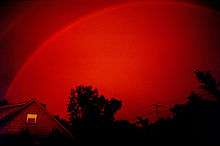Monochrome rainbow
A monochrome or red rainbow is an optical and meteorological phenomenon and a rare variation of the more commonly seen multicolored rainbow. Its formation process is identical to that of a normal rainbow (namely the reflection/refraction of light in water droplets), the difference being that a monochrome rainbow requires the sun to be close to the horizon; i.e., near sunrise or sunset. The low angle of the sun results in a longer distance for its light to travel through the atmosphere, causing shorter wavelengths of light, such as blue, green and yellow, to be scattered and leaving primarily red.[1] In the lower light environment where the phenomenon most often forms, a monochrome rainbow can leave a highly dramatic effect.

Unenhanced photo of a Red Rainbow, taken near Minneapolis in July 1980
References
- Groth, Ed; Foster, Jim (2011-09-10). "Red Rainbow at Sunrise - Earth Science Picture of the Day". NASA Earth Science Division. Retrieved 2013-06-27.
Further reading
- Sistek, Scott (24 November 2011). "Red Rainbows, Glorious Sunrises and a Very Unlucky Weather Station". KOMO News. Retrieved 27 June 2013.
- Cowley, Les. "Red Rainbows". Atmospheric Optics. Retrieved 22 June 2016.
This article is issued from Wikipedia. The text is licensed under Creative Commons - Attribution - Sharealike. Additional terms may apply for the media files.